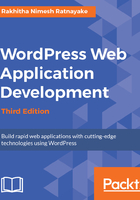
What this book covers
Chapter 1, WordPress As a Web Application Framework, walks you through the existing modules and techniques to identify their usage in web applications. Identification of WordPress features beyond the conventional CMS and planning the forum management application are the highlights of this chapter.
Chapter 2, Implementing Membership Roles, Permissions, and Features, covers the built-in user management features and user permission concepts. Beginning the development of forum management application, implementing basic user management features such as login, registration and introduction to the MVC process through custom routing are the highlights of this chapter.
Chapter 3, Planning and Customizing Core Database, serves as an extensive guide for understanding the core database structure and the role of custom database tables in web applications. Database querying with built-in functions, creating custom tables, and identifying the limitations in core database tables are the highlights of this chapter.
Chapter 4, Building Blocks of Web Applications, explores the possibilities of using custom post types to extend WordPress posts beyond its conventional usage. Managing custom post types, loading custom templates and learn to speed up development process with existing custom post type plugins are the highlights of this chapter.
Chapter 5, Implementing Application Content Restrictions, focuses on identifying the different user types in applications and the possibilities of providing different content permissions based on those user types. Applying content restrictions to WordPress core features, implementing basic content restriction techniques, and innovating new content restriction strategies are the highlights of this chapter.
Chapter 6, Developing Pluggable Modules, introduces the techniques of creating highly reusable and extensible plugins to enhance the flexibility of web applications. Developing various flexible plugins, handling plugin dependencies, and the use of WordPress actions and filters in applications are the highlight of this chapter.
Chapter 7, Customizing Dashboard for Powerful Backends, walks you through the process of customizing the WordPress admin panel for adding new features as well as changing existing features and design. Building flexible data lists with WordPress admin tables, designing an admin panel with various different techniques, and understanding useful admin section settings are the highlights of this chapter.
Chapter 8, Adjusting Theme for Amazing Frontends, dives into the techniques of designing amazing layouts, thereby opening them for future extension. Widgetizing layouts and building reusable templates are the highlights of this chapter.
Chapter 9, Enhancing the Power of Open Source Libraries and Plugins, explores the use of the latest trending open source technologies and libraries within and outside WordPress core . Integrating open authentication in to your web application, structuring the application at the client side, and identify the proper usage of open source plugins in application development, are the highlights of this chapter.
Chapter 10, Listening to Third-party Applications, demonstrates how to use WordPress XML-RPC API and REST API to create custom API’s for your web application. Building a simple XML-RPC API, identifying support for REST in WordPress core and building custom REST API’s are highlights of this chapter.
Chapter 11, Integrating and Finalizing Forum Management Application, guides you through the integration of modules and adds new features to the existing modules, while refactoring the code developed throughout this book. Identifying the use of proper theme templates and completing the features developed throughout the previous chapters are the highlights of this chapter
Chapter 12, Supplementary Modules for Web Development, introduces the advanced application features such as E-commerce, multisite, and the non-functional WordPress features that defines the quality of a web applications. Introduction to important concepts in application development, such as internationalization, caching, security, performance, version control, site migration, and testing are the highlight of this chapter.
Appendix, Configurations, Tools, and Resources, provides an application setup guide with necessary links to download the plugins and libraries used throughout the book.